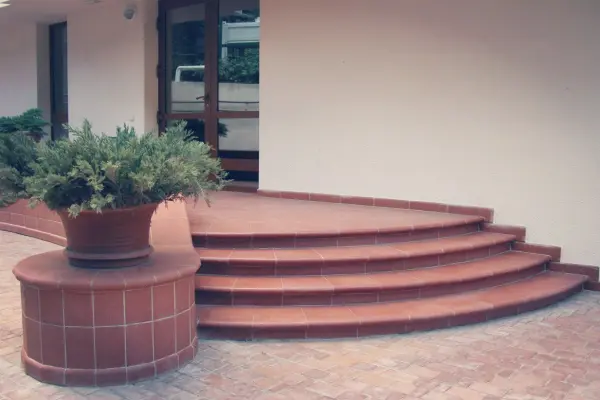Porch design plays a key role in the visual perception of a house, so it is important to carefully approach the choice of both the structure itself and the material for facing the steps and entrance area. The right choice of materials for the porch can literally transform your home! According to research from 2025, properly selected porch tiles can increase the market value of a house by 3-5% and pay for themselves within 3-4 years due to their durability. And this is not surprising! The porch is the first thing that guests see when entering your home.
Tiles for outdoor steps and porches should be not only attractive but also safe. To be honest, many homeowners forget about functionality, giving preference to aesthetics. Don't make this mistake! When choosing a material, pay attention to the surface - it should not be slippery, and also make sure it is securely attached to the base. In the US, about 1 million injuries occur annually due to slippery outdoor surfaces - a compelling argument for anti-slip tiles. Floor tiles for porches have become a real salvation for residents of regions with high humidity.
For steps, it's important to choose a material that is resistant to mechanical damage and climate changes, including sharp temperature fluctuations, severe frosts, and prolonged precipitation. Outdoor tiles for homes work in extreme conditions. Quality porch tiles should withstand not only the whims of weather but also the intensive impact of footwear, as sand on soles acts like sandpaper, gradually wearing away even the most durable surfaces. When I worked with different materials on my own property, I noticed that low-quality tiles begin to lose their attractive appearance after just 1-2 seasons.
"When choosing tiles for the entrance area of the house, you should be guided by the three F rule: frost resistance, functional strength, and fluid absorption minimum. Porcelain stoneware with a water absorption rate of less than 0.5% will withstand up to 100 freeze-thaw cycles, making it ideal for regions with harsh climates," advises Alexander Miller, a finishing materials specialist with 15 years of experience.
Types of Tiles for Facing Porches and Outdoor Steps
Any tile designed for outdoor use will be suitable for a porch. The choice is enormous. The construction market offers many types of materials, each with its own advantages and application features. Many builders note that three main options are the most popular: clinker tiles, porcelain stoneware, and concrete tiles. Which one to choose for your home? Let's take a closer look at them from a practical point of view.
Clinker Tiles for Steps and Porches
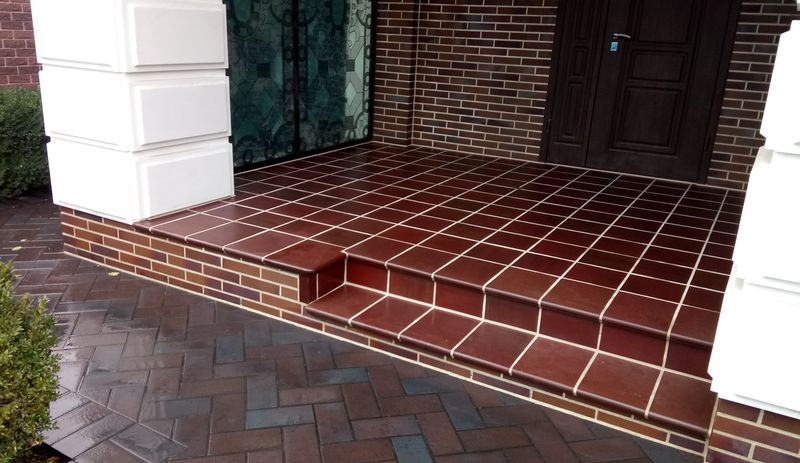 Clinker tiles are made from special types of refractory clay. These outdoor tiles are characterized by high strength and resistance to abrasion. Like granite! But much more affordable in price. I was pleasantly surprised when I discovered that quality clinker tiles costing $30-35 per sq. m look no worse than natural stone at $70-80. They are used for facing entrance groups and steps due to excellent performance characteristics:
Clinker tiles are made from special types of refractory clay. These outdoor tiles are characterized by high strength and resistance to abrasion. Like granite! But much more affordable in price. I was pleasantly surprised when I discovered that quality clinker tiles costing $30-35 per sq. m look no worse than natural stone at $70-80. They are used for facing entrance groups and steps due to excellent performance characteristics:
- Frost resistance up to 300 freeze-thaw cycles
- Low water absorption (up to 3%)
- High mechanical strength
- Anti-slip surface
- Resistance to aggressive chemicals
According to the international standard ISO/TR 17870-1:2015, dedicated to ceramic tile installation, clinker is the optimal choice for exterior cladding in regions with temperature fluctuations. Besides functionality, clinker tiles for porches are attractive in their aesthetic appearance and available in various colors. Many specialists compare clinker tiles to a good foundation - it's hidden from view but is responsible for the durability of the entire structure.
Porcelain Stoneware for Porches and Step Cladding
 Porcelain stoneware for porch cladding is a durable and wear-resistant material that is produced by pressing and firing a mixture of clay, sand, and mineral additives. It comes in different types, including those with volumetric patterns or textures that make the surface anti-slip and visually attractive. Textured tiles for outdoors are an excellent solution for those who value the combination of safety and beauty. For outdoor use, unpolished porcelain stoneware with a matte or structured surface should be chosen.
Porcelain stoneware for porch cladding is a durable and wear-resistant material that is produced by pressing and firing a mixture of clay, sand, and mineral additives. It comes in different types, including those with volumetric patterns or textures that make the surface anti-slip and visually attractive. Textured tiles for outdoors are an excellent solution for those who value the combination of safety and beauty. For outdoor use, unpolished porcelain stoneware with a matte or structured surface should be chosen.
The main advantages of porcelain stoneware for step finishing:
- High frost resistance
- Minimal water absorption (less than 0.5%)
- Wide selection of designs, including imitation of natural stone
- Durability (service life up to 50 years with proper installation)
- High resistance to abrasion (PEI class IV-V)
Practical experience shows that porcelain stoneware for steps can imitate various natural materials - granite, marble, sandstone, wood - allowing you to choose an option for any architectural style of the house. Wood-look tiles for porches are especially popular in country houses of Scandinavian style. By the way, for porches, it is recommended to choose tiles with an anti-slip rating of at least R11. Wear-resistant tiles with a high abrasion class will serve for decades even with intensive use.
Concrete and Paving Tiles for Porches
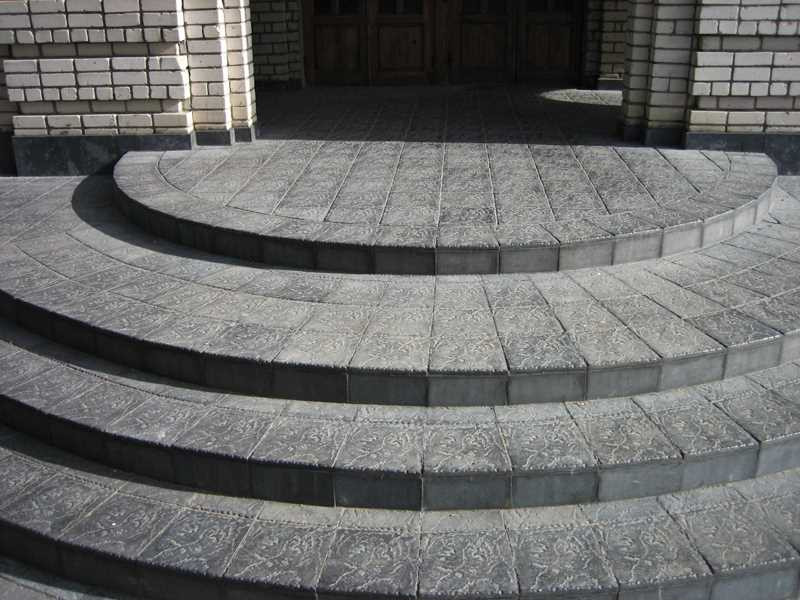 Concrete and paving tiles are the most affordable options for finishing steps and porches. They are made from concrete with added dyes and plasticizers. Their main advantage is low cost and ease of installation. Such materials are suitable for porch cladding in traditional style houses or as a temporary solution.
Concrete and paving tiles are the most affordable options for finishing steps and porches. They are made from concrete with added dyes and plasticizers. Their main advantage is low cost and ease of installation. Such materials are suitable for porch cladding in traditional style houses or as a temporary solution.
Characteristics of concrete tiles for porches:
- Medium frost resistance (up to 100 cycles)
- Satisfactory wear resistance
- High water absorption (5-8%)
- Wide range of shapes and colors
- Affordable price (from $10 per sq. m)
Practicing craftsmen note that compared to porcelain stoneware and clinker, concrete tiles for step cladding have a shorter service life and require periodic renewal of the protective coating. But their easy replacement and low cost make this option popular for budget construction. Paving tiles for steps are like a simple family car: nothing special, but they fulfill their functions.
| Tile Type | Frost Resistance (cycles) | Water Absorption (%) | Anti-slip Properties (R-rating) | Price Range ($/sq.m) | Service Life (years) |
|---|---|---|---|---|---|
| Clinker Tiles | 250-300 | 2-3 | R11-R13 | 25-45 | 50+ |
| Porcelain Stoneware | 100-150 | 0.1-0.5 | R10-R12 | 20-60 | 40-50 |
| Concrete Tiles | 50-100 | 5-8 | R9-R11 | 10-25 | 15-25 |
| Natural Stone | 200-300 | 0.5-4 | R10-R13 | 40-120 | 70+ |
| Polymer-sand Tiles | 100-150 | 1-3 | R10-R12 | 15-30 | 30-40 |
The comparative table above demonstrates the key characteristics of various types of tiles for porch and step cladding. When choosing a material, you should focus not only on the price but also on the operating conditions, climatic features of the region, and the style of your home. Practice shows that quality material costs more but saves significant funds on repairs in the long term. Materials for porches are a long-term investment in the comfort and safety of your home.
Key Characteristics of Tiles for Outdoor Steps and Porches
When choosing tiles for porches and steps, it is necessary to pay attention to several important characteristics that will ensure the durability and safety of the covering. Not everything that is beautiful is practical. Especially in conditions of active exploitation and capricious weather.
Anti-slip Properties of Tiles for Step Cladding
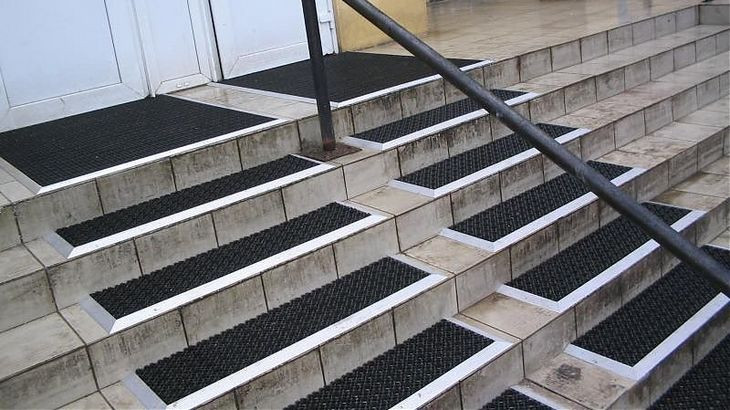 Safety is one of the main criteria when choosing floor tiles for a porch. International standards classify materials by degree of slip resistance using the R-rating (from R9 to R13). For outdoor steps, it is recommended to choose tiles with a rating of at least R11, which meets the requirements of the DIN 51130 standard. Non-slip tiles for porches are not a luxury, but a necessity!
Safety is one of the main criteria when choosing floor tiles for a porch. International standards classify materials by degree of slip resistance using the R-rating (from R9 to R13). For outdoor steps, it is recommended to choose tiles with a rating of at least R11, which meets the requirements of the DIN 51130 standard. Non-slip tiles for porches are not a luxury, but a necessity!
Once I observed how an elderly neighbor slipped on the wet steps of her porch after rain. Fortunately, there were no serious injuries, but after this incident, she immediately replaced the glossy tiles with special anti-slip ones. This example clearly demonstrates how important it is to pay attention not only to aesthetic but also to practical characteristics of materials.
"It is impossible to overestimate the importance of anti-slip properties of porch tiles. Statistics show that in the UK, about 40,000 cases of falls on slippery steps are recorded annually. To reduce this risk, choose tiles with a relief or structured surface, and also pay attention to special anti-slip coatings that can be applied to already laid tiles," recommends Emma Johnson, a specialist in residential safety.
Frost Resistance of Outdoor Tiles
Tiles for outdoor use must withstand multiple cycles of freezing and thawing without losing their properties and breaking down. This indicator is especially important for regions with cold winters. According to practical tests, porcelain stoneware with low water absorption (less than 0.5%) can withstand up to 100 freeze-thaw cycles, and clinker tiles - up to 300 cycles.
When testing various tile samples, experts found that quality material should maintain its strength and appearance after at least 50 cycles of freezing and thawing. This is the minimum for operation in a cold climate. The European standard EN 14411 defines the methodology for testing tile frost resistance and minimum requirements for different climatic zones. Frost-resistant tiles are like good winter clothing - they protect you inconspicuously in the harshest conditions.
Waterproof tiles are also key for outdoor applications. The less moisture the material absorbs, the less likely it is to break down when frozen. Tiles for outdoor applications should have a water absorption rate of no more than 3%, and ideally - less than 1%.
Wear Resistance of the Coating for Steps
The degree of resistance to abrasion determines the durability of tiles in conditions of intensive pedestrian traffic. For porches and steps, it is recommended to choose materials with a high abrasion class (PEI IV–V according to the classification of the European Institute of Ceramics). Such tiles will serve for many years without visible signs of wear.
In practical terms, when choosing floor tiles for a porch, be sure to check the PEI value indicated on the package or in the technical specifications. For the entrance area of a private house, PEI IV class tiles are suitable, and for public buildings with high traffic - PEI V. According to manufacturers, PEI IV class tiles can withstand up to 10,000 passes per day without visible signs of wear. Microstone for porch cladding also demonstrates excellent wear resistance indicators, approaching the characteristics of natural stone.
"Our family was looking for the perfect solution for the porch of our house in the suburbs of Kyiv. Initially, we considered natural stone, but its cost ($60 per sq. m) was beyond our budget. After consulting with a designer, we chose porcelain stoneware with a slate texture and an R11 rating. The tiles cost us $30 per sq. m, and the result exceeded all expectations! For the third winter, it has been excellently withstanding frosts down to -20°C and looks like new. Most importantly - we forgot about the problem of slippery steps, even during ice. For us with two small children, this was the deciding factor," shares Natalia, a homeowner from the Kyiv region.
Practical Guide to Choosing Tiles for Porches and Step Finishing
Choosing suitable tiles for porch cladding requires consideration of many factors - from climatic conditions to the architectural style of the house. Based on the experience of professional builders and homeowner reviews, we have compiled practical recommendations that will help make the right choice. It's like a navigator on an unfamiliar road - it helps avoid mistakes and save time.
Consideration of Climatic Conditions When Choosing Tiles for Steps
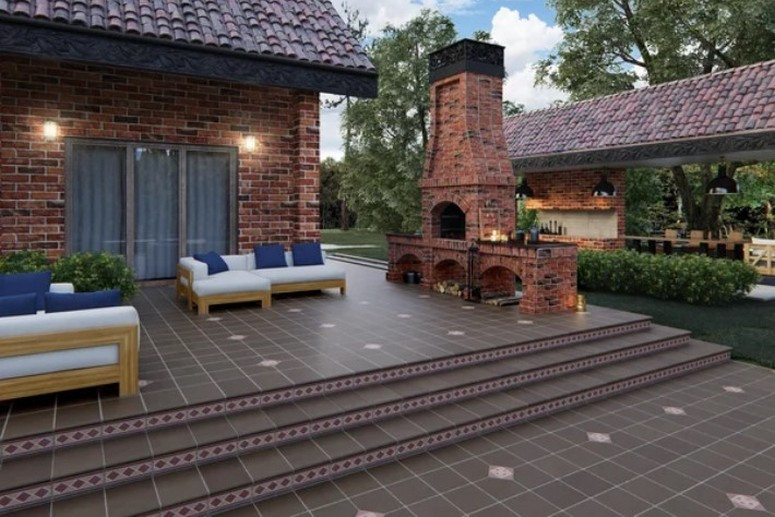 Climate directly affects the operational requirements for materials for outdoor use. In regions with frequent precipitation and temperature fluctuations, it is important to choose tiles with low water absorption and high frost resistance. Users on forums and specialized resources often note that the experience of using tiles in winter can differ significantly from the stated characteristics.
Climate directly affects the operational requirements for materials for outdoor use. In regions with frequent precipitation and temperature fluctuations, it is important to choose tiles with low water absorption and high frost resistance. Users on forums and specialized resources often note that the experience of using tiles in winter can differ significantly from the stated characteristics.
- For cold climates (with minimum temperatures below -15°C): clinker tiles with frost resistance of at least 200 cycles or porcelain stoneware with water absorption less than 0.2%
- For moderate climates: porcelain stoneware with a frost resistance index of at least 100 cycles
- For humid climates: materials with water absorption less than 3% and anti-fungal treatment
- For hot climates: tiles with heat-reflecting properties or light shades with UV protection
Practical advice: in regions where the temperature in winter drops below -15°C, pay special attention to the installation technology. According to the recommendations of the standard ISO/TR 17870-1:2015, it is necessary to use special frost-resistant adhesive compounds and provide expansion joints to compensate for the thermal expansion of materials. Outdoor tiles for houses in cold regions are a special category of materials, which requires increased attention.
Design and Aesthetics of Porch Tiles
Tiles for the entrance area should harmonize with the overall architectural solution of the house. This is the face of your dwelling. In 2025, the following design solutions are especially popular:
- Natural stone-look tiles for classic and country styles
- Monochrome solutions for modern minimalist houses
- Tiles with geometric patterns for eclectic styles
- Large-format slabs (60x60 cm and larger) for visually expanding the space
- Decorative elements for the porch in the form of mosaic inserts or contrasting borders
From a practical point of view, when choosing a color, keep in mind that light-colored tiles will be more susceptible to dirt and will require more frequent cleaning, and dark ones - to heating in the sun, which can create discomfort in hot weather. The optimal option is medium tones with a textured surface that hides minor dirt. Color solutions for tiles are best chosen based on the main tones of the facade and roof - this will create a harmonious composition.
Builders also recommend choosing tiles with a small margin (about 10-15%) in case of damage to individual elements in the future. Tiles for terraces and porches are often chosen from the same collection to create a unified style for the exterior areas of the house.
Safety of Using Tiles for Outdoor Steps
Safe movement on the porch should be the main priority when choosing tiles. For this, pay attention to the following practical points:
- Slip resistance coefficient (R-rating) not lower than R11 for outdoor steps
- Relief or structured surface, especially for regions with frequent precipitation
- Special elements for steps with a rounded front edge (drip nose) for water drainage
- Contrasting colors to indicate height differences (especially important for people with weakened vision)
- Use of steps with anti-slip strips or inserts
Professional craftsmen recommend using a combination of materials for maximum safety - for example, the main surface of the steps made of porcelain stoneware, and the edge - of a contrasting anti-slip strip. Such a solution meets safety standards and significantly reduces the risk of injuries, especially in adverse weather conditions. The installation of tiles on steps should be done with particular care, adhering to all technological requirements.
Practical Tips for Tile Care on Porches and Steps
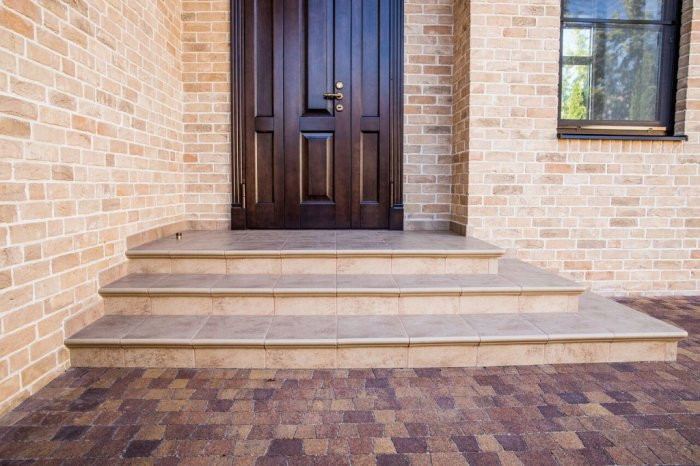 Although there are no special rules for porch tile care, there are practical recommendations that will help maintain its appearance and extend its service life. Proper care is like regular training for your body. Small efforts now will preserve beauty and functionality for a long time.
Although there are no special rules for porch tile care, there are practical recommendations that will help maintain its appearance and extend its service life. Proper care is like regular training for your body. Small efforts now will preserve beauty and functionality for a long time.
- Regular cleaning: Remove dirt and debris from the tile surface at least once a week. Use a soft brush or broom to remove leaves, sand, and other contaminants. Practice shows that sand and small pebbles act as an abrasive, gradually damaging the surface.
- Washing tiles: For washing tiles, use mild detergents designed for outdoor work. Avoid aggressive cleaning agents containing acids or alkalis that can damage the tile surface and grout.
- Protection from scratches: For glazed tiles, use a soft sponge or cloth. Avoid using hard brushes or metal scrapers that can scratch the glazed surface.
- Cleaning joints: The joints between tiles also need care. Use soft brushes to remove dirt and mold from joints. If necessary, you can use special mold removal agents, following the manufacturer's instructions.
- Freezing prevention: In cold weather, make sure that water does not accumulate on the surface of the tiles, as this can lead to their destruction when frozen. Promptly clean the porch of snow and ice, using plastic shovels to avoid damaging the surface.
- Use of protective coatings: Consider using special protective impregnations that create a water-repellent layer, prevent stain formation, and facilitate cleaning. Update such coating according to the manufacturer's recommendations, usually 1-2 times a year.
- Periodic integrity check: Regularly check the tiles for cracks or chips. If damage is detected, promptly repair or replace damaged elements to prevent the spread of destruction.
How to care for tiles on the porch? Do it regularly and with the right materials. Professional builders recommend conducting more thorough cleaning and treatment with protective compounds twice a year - in spring after the winter season and in autumn before the onset of cold weather. This approach significantly extends the service life of the cladding and preserves its attractive appearance. The coating for steps will last much longer with proper care.
Innovations in the Production of Tiles for Porches and Outdoor Steps
Modern technologies do not stand still, and in the field of tile production for outdoor use, interesting innovations are emerging that make materials even more durable and safe. You can't keep up with all the novelties! The practical application of these developments has already proven their effectiveness in everyday use.
- Digital Print Technology - allows creating tiles with realistic imitation of natural materials, while maintaining all the advantages of ceramics
- Heat-reflecting coatings - reduce surface heating in the sun by up to 15°C, which is especially relevant for regions with hot climates
- Antibacterial additives - prevent the formation of mold and fungus even in conditions of increased humidity
- Self-cleaning surfaces - with a hydrophobic effect that repels water and dirt, which significantly simplifies care
- Eco-friendly production - using recycled materials, which reduces the carbon footprint and meets modern requirements for sustainable development
- Integrated anti-slip inserts - allow combining aesthetics and safety without compromises
- Tiles with C3 technology for steps - an innovative development with enhanced anti-slip properties and increased resistance to extreme temperatures
According to the European Association of Ceramic Manufacturers, about 30% of tiles in Europe are produced using recycled materials, which reduces the carbon footprint by 15% compared to traditional methods. This is an important step towards environmentally responsible construction, which also provides practical benefits in the form of tax incentives for manufacturers and consumers in some countries. House step cladding with modern materials is not only beautiful but also environmentally friendly.
Choosing suitable tiles for porch and step cladding is an important step that will determine not only the aesthetics of the entrance area but also the safety and durability of the covering. Considering the climatic features of your region, the intensity of use, and the architectural style of the house, you can choose the optimal option that will please you for many years. Tiles for the entrance area are not just a building material, but a calling card of your home.
